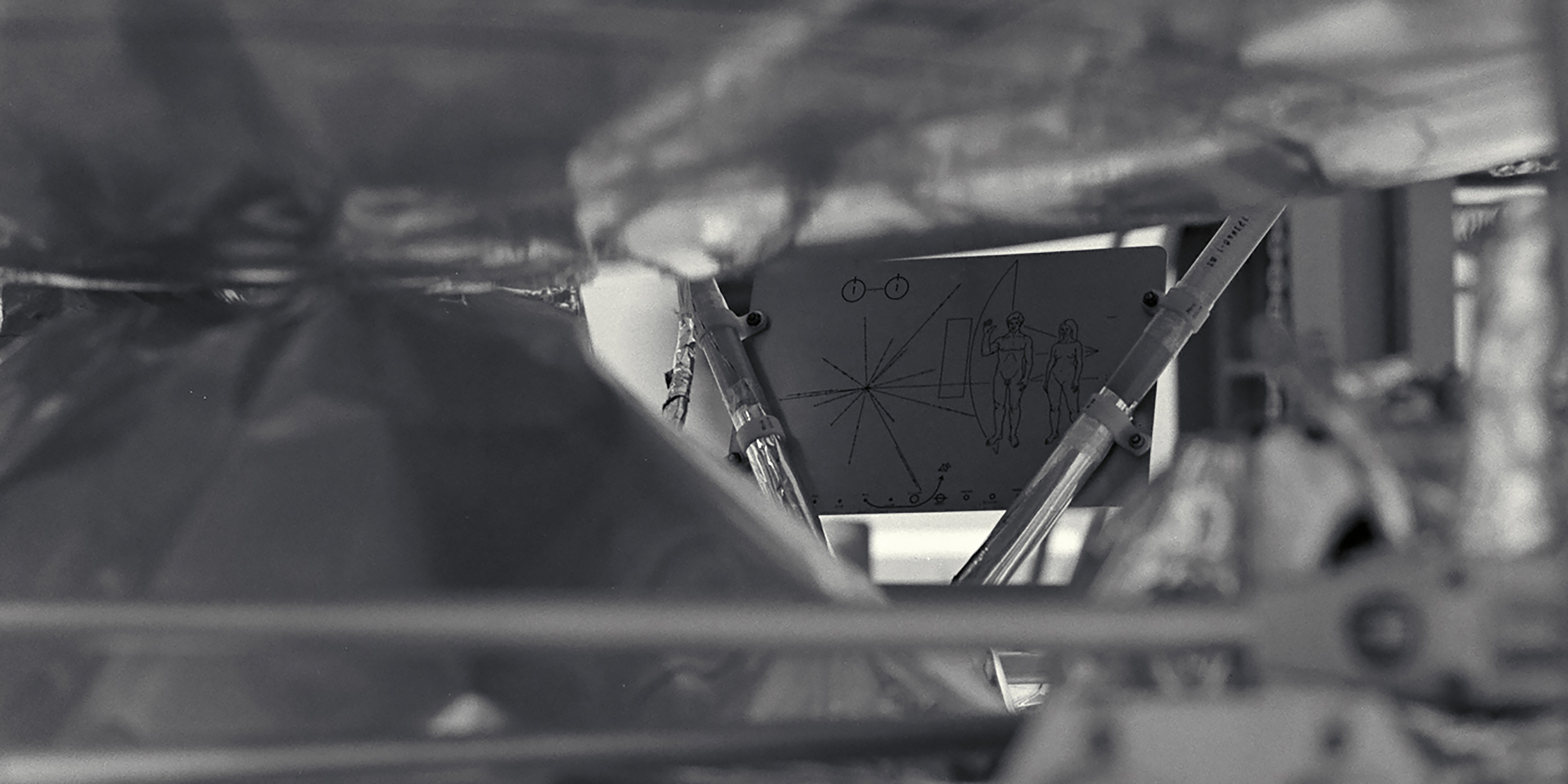Originally published 30 April 2002
Remember 1972? Led Zeppelin. Carly Simon. The Godfather. Hawaii Five‑O. George Wallace shot. Watergate. Bombing raids on North Vietnam.
Murders at the Summer Olympics. Mark Spitz. Pioneer 10.
Pioneer 10?
The little spacecraft with the big antenna blasted off March 2, 1972, on top of an Atlas-Centaur rocket. Pioneer 10 was going to be the first human artifact to leave the solar system.
The news media was atwitter because of the plaque affixed to the side of the craft, which Carl Sagan helped design, meant as an Earthly greeting to whatever alien civilization the spacecraft might someday encounter.
There were protests, as I recall, because the plaque depicted a nude human male and female (“Dirty pictures,” said letters to editors). But most objections were not to the nudity — after all, this was at the height of the Sexual Revolution — but because some people thought the images were politically incorrect.
It was the male who raised his hand in greeting, not the female (male chauvinism!). The male’s genitals were shown, but not the female’s (sexism!). And the figures — deliberately designed to be multiracial — were thought by some to be too Caucasian, by others too Negroid (racism!).
Those were highly charged times, and today the controversies seem rather quaint. After all, the chance that an intelligent alien civilization will ever see the plaque is exceedingly slim. Pioneer 10 is heading in the direction of the constellation Taurus, but won’t pass the nearest star there for 2 million years.
In fact, the spacecraft is not yet in true interstellar space. It passed the orbit of Pluto in 1983, and thus left the solar system by some accounts, but it still lies within the influence of the Sun’s magnetic field and outward flow of solar particles. Sometime in the next few years, it will leave even that gentle touch of the Sun behind.
Thirty years into its voyage, Pioneer 10 is more than 7 billion miles away, and still in radio contact with Earth. Scientists last contacted the craft on March 2 of this year [2002], beaming a signal to the spaceship’s receiver and getting a response. The round-trip communication took 22 hours, traveling at the speed of light. By comparison, a radio signal takes just 8 minutes to travel from the Earth to the sun.
Of the craft’s 11 scientific instruments, only one, a Geiger Tube Telescope, is still working.
Pioneer 10 is nuclear powered, so there’s no problem of batteries running out, but it’s something of a miracle that the spacecraft has not yet cut its electronic umbilical cord to Earth. Its sister ship, Pioneer 11, launched in 1973 and hot on the tail of Pioneer 10, has been out of touch since 1995.
I love thinking of that chunk of human engineering drifting in deep space, heading for the stars, never to return, its radio squeaking a barely detectable homesick cry, those little naked figures affixed to its side facing the unfathomable gulf between the stars, the male’s hand raised in hopeful greeting.
The craft was launched in turbulent times, wonderful and terrible.
But most of all those times were hopeful. The peace movement was in full swing, with its dream of global harmony. Ecology and green politics.
Women’s liberation. Civil rights. The Peace Corps. Liberation theology. Flower power.
For all of the chaos that swirled about us, there was a dream that things could be better, that all humans could live in peace and equality, irrespective of gender, race, culture, or religion. The young, especially, were convinced that the dawning of the Age of Aquarius meant an end to ancient animosities and injustices.
They were wrong, of course. Greed, hatred, and intolerance are still with us. Perhaps they will always be with us. Perhaps they are embedded in our genes.
But the dream lives on, and thankfully so. We know we are not prisoners of our genes, and that we can rise above our baser instincts if only we can rally ourselves to try. We hold to the hope that on this tiny planet of a yellow star in a typical corner of the Milky Way Galaxy, we might yet create an oasis of creaturely order that is a model for the universe.
Pioneer 10 carries that hope into interstellar space. With Pioneer 11 and Voyagers I and II, which also carry messages, it is an emissary of our best natures. The Voyagers bear musical selections from different cultures and eras, and spoken greetings from humans in 55 languages. That magnanimity of spirit was typical of the era in which the spacecraft were launched. Let us hope we can become worthy of the self-image we sent to the stars.
The last successful radio contact with Pioneer 10 occurred in 2003. It is now estimated the spacecraft is over 11 billion miles from Earth. ‑Ed.



